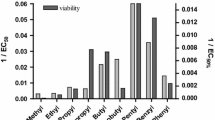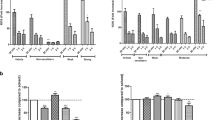Abstract
Allergic contact dermatitis is a widespread health disorder and occupational skin disease. Hence, screening for contact-sensitizing chemicals is highly relevant to toxicology, dermatology, and occupational medicine. The use of animal tests for this purpose is constrained by ethical considerations, need for high-throughput screening, and legislation (e.g., for cosmetics in the European Union). T cell activation is the final and most specific key event of the “adverse outcome pathway” for skin sensitization and therefore a promising target for the development of in vitro sensitization assays. We present a novel in vitro sensitization assay with a lymphocyte endpoint as an add-on to the loose-fit coculture-based sensitization assay (LCSA): the LCSA-ly. While the LCSA measures dendritic cell activation, the LCSA-ly offers the option for an additional lymphocyte endpoint which can be measured concurrently. We incorporated lymphocytes in our previously established coculture of primary human keratinocytes and monocyte-derived dendritic cells and tested nine substances: five sensitizers [2,4-dinitrochlorobenzene (DNCB) 1.25–15 µmol/l, p-phenylenediamine (PPD) 15.6–125 µmol/l, 2-mercaptobenzothiazole (MBT) 50–1000 µmol/l, coumarin, and resorcinol (both: 250–1500 µmol/l)] and four non-sensitizers (monochlorobenzene, caprylic acid, glycerol, and salicylic acid (all: 125–1000 µmol/l)]. DNCB and MBT increased a subset of IL-23 receptor+/IFN-γ receptor 1 (CD119)+ lymphocytes. DNCB, PPD, and MBT enhanced a subunit of the IL-4 receptor (CD124) and a memory marker (CD44) on lymphocytes. Remarkably, DNCB, PPD, and MBT raised IL-4 concentrations in coculture supernatants while IFN-γ levels decreased, which might point to Th2 activation in vitro. Coumarin, resorcinol, and non-sensitizers did not alter any of the tested surface markers or cytokines. IL-17 was not affected by any of the substances. Relative strength of sensitizers according to lymphocyte markers was DNCB > PPD > MBT, which corresponds to earlier results from the LCSA without lymphocyte endpoint, the murine local lymph node assay, and human data. This study is the first to prove the suitability of lymphocyte surface markers for sensitization testing and potency assessment.


Similar content being viewed by others
References
Ahmed SS, Wang XN, Fielding M et al (2016) An in vitro human skin test for assessing sensitization potential. JAT 36(5):669–684. https://doi.org/10.1002/jat.3197
Ashby J, Basketter DA, Paton D, Kimber I (1995) Structure activity relationships in skin sensitization using the murine local lymph node assay. Toxicology 103(3):177–194
Ashikaga T, Yoshida Y, Hirota M et al (2006) Development of an in vitro skin sensitization test using human cell lines: the human cell line activation test (h-CLAT). I. Optimization of the h-CLAT protocol. Toxicol In vitro Int J Publ Assoc BIBRA 20(5):767–773. https://doi.org/10.1016/j.tiv.2005.10.012
Basketter DA, Alepee N, Ashikaga T et al. (2014) Categorization of chemicals according to their relative human skin sensitizing potency. Dermatitis: contact, atopic, occupational. Drug 25(1):11–21 https://doi.org/10.1097/DER.0000000000000003
Bellinghausen I, Brand U, Enk AH, Knop J, Saloga J (1999) Signals involved in the early TH1/TH2 polarization of an immune response depending on the type of antigen. J Allergy Clin Immunol 103(2 Pt 1):298–306
Dearman RJ, Moussavi A, Kemeny DM, Kimber I (1996) Contribution of CD4+ and CD8+ T lymphocyte subsets to the cytokine secretion patterns induced in mice during sensitization to contact and respiratory chemical allergens. Immunology 89(4):502–510
Dietz L, Esser PR, Schmucker SS et al (2010) Tracking human contact allergens: from mass spectrometric identification of peptide-bound reactive small chemicals to chemical-specific naive human T-cell priming. Toxicol Sci 117(2):336–347. https://doi.org/10.1093/toxsci/kfq209
Dutton RW, Bradley LM, Swain SL (1998) T cell memory. Annu Rev Immunol 16:201–223. https://doi.org/10.1146/annurev.immunol.16.1.201
Frombach J, Sonnenburg A, Krapohl BD, Zuberbier T, Stahlmann R, Schreiner M (2017) A novel method to generate monocyte-derived dendritic cells during coculture with HaCaT facilitates detection of weak contact allergens in cosmetics. Arch Toxicol 91(1):339–350. https://doi.org/10.1007/s00204-016-1722-y
Huang H, Paul WE (1998) Impaired interleukin 4 signaling in T helper type 1 cells. J Exp Med 187(8):1305–1313
Krasteva M, Peguet-Navarro J, Moulon C, Courtellemont P, Redziniak G, Schmitt D (1996) In vitro primary sensitization of hapten-specific T cells by cultured human epidermal Langerhans cells—a screening predictive assay for contact sensitizers. Clin Exp Allergy J Br Soc Allergy Clin Immunol 26(5):563–570
Leist M, Hasiwa N, Rovida C et al (2014) Consensus report on the future of animal-free systemic toxicity testing. Altex 31(3):341–356. https://doi.org/10.14573/altex.1406091
Maecker HT, Lindstrom TM, Robinson WH et al (2012) New tools for classification and monitoring of autoimmune diseases. Nat Rev Rheumatol 8(6):317–328. https://doi.org/10.1038/nrrheum.2012.66
Martin SF, Esser PR, Schmucker S et al (2010) T-cell recognition of chemicals, protein allergens and drugs: towards the development of in vitro assays. CMLS 67(24):4171–4184. https://doi.org/10.1007/s00018-010-0495-3
Novelli F, D’Elios MM, Bernabei P et al (1997) Expression and role in apoptosis of the alpha- and beta-chains of the IFN-gamma receptor on human Th1 and Th2 clones. J Immunol 159(1):206–213
OECD (2014) The adverse outcome pathway for skin sensitisation initiated by covalent binding to proteins. OECD, Paris
OECD (2016) Annex I: guidance document on the reporting of defined approaches and individual information sources to be used within integrated approaches to testing and assessment (IATA) for skin sensitisation. OECD, Paris
Opdyke DL (1981) Monographs on fragrance raw materials. Food Cosmet Toxicol 19(2):237–254
Overton WR (1988) Modified histogram subtraction technique for analysis of flow cytometry data. Cytometry 9(6):619–626. https://doi.org/10.1002/cyto.990090617
Parham C, Chirica M, Timans J et al (2002) A receptor for the heterodimeric cytokine IL-23 is composed of IL-12Rbeta1 and a novel cytokine receptor subunit, IL-23R. J Immunol 168(11):5699–5708
Peiser M (2013) Role of Th17 cells in skin inflammation of allergic contact dermatitis. Clin Dev Immunol 2013:261037. https://doi.org/10.1155/2013/261037
Peiser M, Tralau T, Heidler J et al (2012) Allergic contact dermatitis: epidemiology, molecular mechanisms, in vitro methods and regulatory aspects. Current knowledge assembled at an international workshop at BfR, Germany. CMLS 69(5):763–781. https://doi.org/10.1007/s00018-011-0846-8
Python F, Goebel C, Aeby P (2007) Assessment of the U937 cell line for the detection of contact allergens. Toxicol Appl Pharmacol 220(2):113–124. https://doi.org/10.1016/j.taap.2006.12.026
Rougier N, Redziniak G, Mougin D, Schmitt D, Vincent C (2000) In vitro evaluation of the sensitization potential of weak contact allergens using langerhans-like dendritic cells and autologous T cells. Toxicology 145(1):73–82
Schreiner M, Peiser M, Briechle D, Stahlmann R, Zuberbier T, Wanner R (2007) A loose-fit coculture of activated keratinocytes and dendritic cell-related cells for prediction of sensitizing potential. Allergy 62(12):1419–1428. https://doi.org/10.1111/j.1398-9995.2007.01511.x
Schreiner M, Peiser M, Briechle D, Stahlmann R, Zuberbier T, Wanner R (2008) A new dendritic cell type suitable as sentinel of contact allergens. Toxicology 249(2–3):146–152. https://doi.org/10.1016/j.tox.2008.04.020
Sonnenburg A, Ahuja V, Schreiner M, Platzek T, Stahlmann R (2012) Assessment of the sensitizing potential of textile disperse dyes and some of their metabolites by the loose-fit coculture-based sensitization assay (LCSA). Arch Toxicol 86(5):733–740. https://doi.org/10.1007/s00204-012-0811-9
Swain SL, Weinberg AD, English M, Huston G (1990) IL-4 directs the development of Th2-like helper effectors. J Immunol 145(11):3796–3806
Urbisch D, Mehling A, Guth K et al (2015) Assessing skin sensitization hazard in mice and men using non-animal test methods. RTP 71(2):337–351. https://doi.org/10.1016/j.yrtph.2014.12.008
Urbisch D, Becker M, Honarvar N et al (2016) Assessment of pre- and pro-haptens using nonanimal test methods for skin sensitization. Chem Res Toxicol 29(5):901–913. https://doi.org/10.1021/acs.chemrestox.6b00055
Valente G, Ozmen L, Novelli F et al (1992) Distribution of interferon-gamma receptor in human tissues. Eur J Immunol 22(9):2403–2412. https://doi.org/10.1002/eji.1830220933
Vocanson M, Cluzel-Tailhardat M, Poyet G et al (2008) Depletion of human peripheral blood lymphocytes in CD25+ cells allows for the sensitive in vitro screening of contact allergens. J Investig Dermatol 128(8):2119–2122. https://doi.org/10.1038/jid.2008.15
Vocanson M, Mutez V, Esser PR et al. (2017) Contact hypersensitivity: T-cell based assay. Curr Opin Toxicol 5(Supplement C):39–45 https://doi.org/10.1016/j.cotox.2017.07.005
Vukmanovic S, Sadrieh N (2017) Skin sensitizers in cosmetics and beyond: potential multiple mechanisms of action and importance of T-cell assays for in vitro screening. Crit Rev Toxicol 47(5):415–432. https://doi.org/10.1080/10408444.2017.1288025
Wanner R, Sonnenburg A, Quatchadze M et al (2010) Classification of sensitizing and irritative potential in a combined in-vitro assay. Toxicol Appl Pharmacol 245(2):211–218. https://doi.org/10.1016/j.taap.2010.02.019
Wong CL, Ghassabian S, Smith MT, Lam AL (2015) In vitro methods for hazard assessment of industrial chemicals—opportunities and challenges. Front Pharmacol 6:94. https://doi.org/10.3389/fphar.2015.00094
Acknowledgements
Studies were supported by a grant from the German Federal Ministry of Education and Research (Grant no. 31P5924). We are also grateful for a grant from the Sonnenfeld Stiftung, Berlin, providing financial support for the FACS Calibur. Some experiments in this study were part of Janna Frombach’s master thesis.
Author information
Authors and Affiliations
Corresponding author
Ethics declarations
Conflict of interest
The authors declare that they have no conflict of interest.
Ethical standards
This article does not contain any studies with human participants or animals performed by any of the authors.
Electronic supplementary material
Below is the link to the electronic supplementary material.
Rights and permissions
About this article
Cite this article
Frombach, J., Sonnenburg, A., Krapohl, BD. et al. Lymphocyte surface markers and cytokines are suitable for detection and potency assessment of skin-sensitizing chemicals in an in vitro model of allergic contact dermatitis: the LCSA-ly. Arch Toxicol 92, 1495–1505 (2018). https://doi.org/10.1007/s00204-018-2164-5
Received:
Accepted:
Published:
Issue Date:
DOI: https://doi.org/10.1007/s00204-018-2164-5




